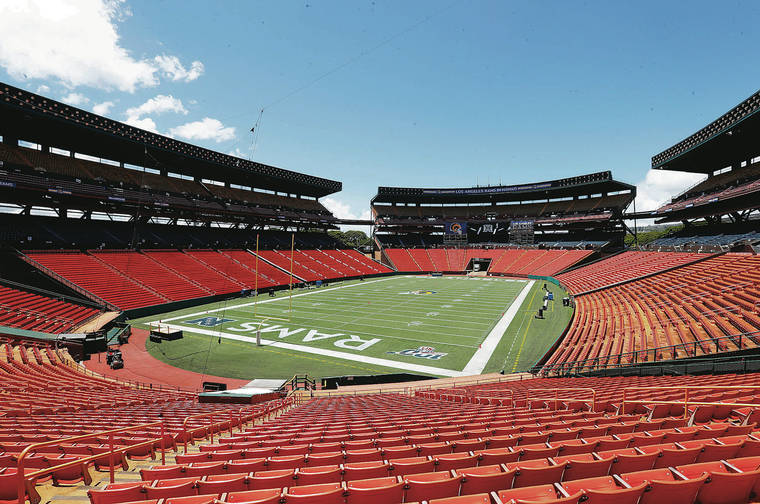As the hand-delivered packets arrive Tuesday at the Department of Accounting and General Services offices on Punchbowl Street, the State will begin to get an idea of where its vision for the New Aloha Stadium Entertainment District is headed.
That is when, after two postponements due to the impact of COVID-19 Opens in a new tab, responses to the state’s March 27 request for qualifications are due and the first of two stages in the procurement process aimed at selecting a private sector partner for the project ramps up.
“May 26 will be like Christmas Day — an opportunity for us to see which developers have the financial muscle and technical expertise to re-create (98) acres in Halawa,” said state Sen. Glenn Wakai (D, Kalihi, Mapunapuna, Salt Lake), in whose district the current, rust-crusted facility sits.
“COVID has had a negative impact on our community, except for our plans for the new Aloha Stadium (and) the State continues to move forward on lining up all the pieces for an on-time delivery,” Wakai said.
From the responses, by which interested developer-led teams indicate their interest and qualifications to design, build, finance and maintain a project of this size, the state has said a select committee will choose up to three priority-listed finalists by June 8 to receive the request for proposal.
“Based on the strong interest we have received from the development industry to this point, we anticipate that it may be difficult selecting only three RFQ respondents to receive the RFP,” said Stacey Jones, owner and principal of Crawford Architects, a state consultant on the project. “This is certainly a great problem to have and a positive indicator for the project.”
The timetable calls for those proposals to be received in October with a decision made in time for a contract with the winning bidder to be closed in the first quarter of 2021. The new facility is scheduled to debut in time for the University of Hawaii football team’s Sept. 2, 2023 home opener against Albany.
Once the selection process hits the RFP stage next month, the state will begin to get a better idea of the total cost of the project, including the P3 partner’s share.
The state is allocating $350 million through a combination of general obligation ($170 million) and revenue bonds ($180 million) and the eventual private sector partner is expected to finance some of the project’s construction costs as well as maintain the facility, which will ultimately determine the overall cost.
“The State will pay for this in a manner akin to a home loan. It will likely pay a substantial amount toward the construction of the facility and then repay the finance component over a period of 25 to 35 years,” said Adam Shaw, executive vice president of WT Partnership, a state consultant on the project.
Rep. Sylvia Luke (D, Makiki, Punchbowl, Nuuanu) said, “This project is not just for the construction of the new stadium but redevelopment of the stadium district.”
Where Hawaii’s approach has differed from some other tourism-driven states is that NASED funding is not directly relying on the transient accommodation tax (TAT) or related visitor taxes.
Luke said, “It is fortuitous that bond funds, rather than TAT, was used,” since the impact of COVID-19 has severely slowed or ground to a halt major projects elsewhere.
“The COVID-19 crisis changed the fate of many projects on the mainland overnight (and) various convention centers, performing arts, arenas and stadium projects are now is distress because of their reliance on funding sources that have substantially evaporated,” Shaw said in an email. “Many of these projects have been developed based on a direct link to visitor taxes such as surcharges on rental cars and hotel occupancy. In contrast, the funding for the state’s contribution to NASED has been facilitated through the state’s general bonding capacity.”
Shaw said, “The Hawaii economy has taken a hit, since the State budget, like many of Hawaii’s businesses, is reliant on a healthy volume of tourism. However, the long-term NASED program affords time for the economic recovery of the State budget. NASED will likely be one of the core economic stimulus projects for the State to kick-start its economy again.”




